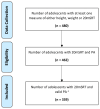Intensity and Duration of Physical Activity and Cardiorespiratory Fitness
- PMID: 35694877
- PMCID: PMC7617045
- DOI: 10.1542/peds.2021-056003
Intensity and Duration of Physical Activity and Cardiorespiratory Fitness
Abstract
Objectives: There is no clear guidance on the intensity and duration of physical activity (PA) that adolescents require to maximise cardiorespiratory fitness (CRF). We aimed to determine the strength of associations between each PA intensity and CRF, independently of other intensities, and the PA duration at each intensity associated with maximal CRF.
Methods: PA and CRF were assessed in 339 adolescents aged 13 to 14 years by wrist-worn accelerometers and 20-m shuttle runs, respectively. Partial regression modeling was used to construct residualized PA variables at each PA intensity that were uncorrelated with each other. Moving average models were optimally fitted to determine relationships between residualized PA variables and CRF. Threshold regression models determined the duration of PA above which CRF improvement was minimal.
Results: Greater vigorous PA (VPA) was associated with better CRF until about 20 minutes of daily VPA, when the relationship plateaued. Moderate and light PA, and sedentary time were not associated with CRF in partial models. Adolescents performing 14 (range 12-17) minutes of daily VPA had median CRF. Participants in the upper quartile of VPA had 1.03 z-scores higher CRF than those in the lowest quartile (95% confidence interval: 0.75 to 1.30).
Conclusions: Our data suggest that 20 minutes of daily VPA may be best for maximizing CRF in adolescence. As moderate-to-vigorous PA guidelines can be satisfied by only undertaking moderate PA, with no apparent independent benefit, we suggest that future guidelines focus on VPA alone, simplifying public health messaging.
Conflict of interest statement
The authors have indicated they have no financial relationships relevant to this article to disclose.
Figures



Comment in
-
Physical Activity Counseling: New Options and a Lighter Burden.Pediatrics. 2022 Jul 1;150(1):e2022057026. doi: 10.1542/peds.2022-057026. Pediatrics. 2022. PMID: 35694878 No abstract available.
Similar articles
-
Cross-Sectional Associations of Objectively-Measured Physical Activity and Sedentary Time with Body Composition and Cardiorespiratory Fitness in Mid-Childhood: The PANIC Study.Sports Med. 2017 Apr;47(4):769-780. doi: 10.1007/s40279-016-0606-x. Sports Med. 2017. PMID: 27558140 Free PMC article.
-
A cross-sectional and prospective analyse of reallocating sedentary time to physical activity on children's cardiorespiratory fitness.J Sports Sci. 2018 Aug;36(15):1720-1726. doi: 10.1080/02640414.2017.1411176. Epub 2017 Dec 1. J Sports Sci. 2018. PMID: 29192846
-
Associations of physical activity, sedentary time, and cardiorespiratory fitness with heart rate variability in 6- to 9-year-old children: the PANIC study.Eur J Appl Physiol. 2019 Dec;119(11-12):2487-2498. doi: 10.1007/s00421-019-04231-5. Epub 2019 Sep 18. Eur J Appl Physiol. 2019. PMID: 31535217 Free PMC article.
-
Is cardiac autonomic function associated with cardiorespiratory fitness and physical activity in children and adolescents? A systematic review of cross-sectional studies.Int J Cardiol. 2017 Jun 1;236:113-122. doi: 10.1016/j.ijcard.2017.02.022. Epub 2017 Feb 10. Int J Cardiol. 2017. PMID: 28238507
-
Physical activity interventions for people with congenital heart disease.Cochrane Database Syst Rev. 2020 Oct 28;10(10):CD013400. doi: 10.1002/14651858.CD013400.pub2. Cochrane Database Syst Rev. 2020. PMID: 33112424 Free PMC article.
Cited by
-
Heteroatoms (Si, B, N, and P) doped 2D monolayer MoS2 for NH3 gas detection.RSC Adv. 2022 Sep 13;12(40):25992-26010. doi: 10.1039/d2ra04028j. eCollection 2022 Sep 12. RSC Adv. 2022. Retraction in: RSC Adv. 2025 Apr 4;15(14):10533. doi: 10.1039/d5ra90040a. PMID: 36199611 Free PMC article. Retracted.
-
The Relationship of the PROMIS® Pediatric Physical Activity Measure with Cardiorespiratory Fitness.Children (Basel). 2023 Dec 24;11(1):22. doi: 10.3390/children11010022. Children (Basel). 2023. PMID: 38255336 Free PMC article.
-
A comparative study between traditional and sports school uniforms on cardiorespiratory and muscular fitness and waist-height-to-ratio in adolescents.Front Public Health. 2023 Jun 28;11:1213403. doi: 10.3389/fpubh.2023.1213403. eCollection 2023. Front Public Health. 2023. PMID: 37457263 Free PMC article.
-
Cardiopulmonary Fitness and Physical Activity Among Children and Adolescents With Inherited Cardiac Disease.JAMA Netw Open. 2025 Feb 3;8(2):e2461795. doi: 10.1001/jamanetworkopen.2024.61795. JAMA Netw Open. 2025. PMID: 39998828 Free PMC article. Clinical Trial.
-
Effects of Endurance Exercise Intensities on Autonomic and Metabolic Controls in Children with Obesity: A Feasibility Study Employing Online Exercise Training.Nutrients. 2023 Feb 20;15(4):1054. doi: 10.3390/nu15041054. Nutrients. 2023. PMID: 36839416 Free PMC article.
References
-
- McKinney J, Lithwick DJ, Morrison BN, et al. The health benefits of physical activity and cardiorespiratory fitness. B C Med J. 2016;58(3):131–137.
-
- Hemmingsson E, Väisanen D, Andersson G, Wallin P, Ekblom-Bak E. Combinations of BMI and cardiorespiratory fitness categories: trends between 1995 and 2020 and associations with CVD incidence and mortality and all-cause mortality in 471 216 adults. Eur J Prev Cardiol. 2021:zwab169. - PubMed
-
- Biddle SJ, Asare M. Physical activity and mental health in children and adolescents: a review of reviews. Br J Sports Med. 2011;45(11):886–895. - PubMed
Publication types
MeSH terms
Grants and funding
LinkOut - more resources
Full Text Sources
Medical
Research Materials

